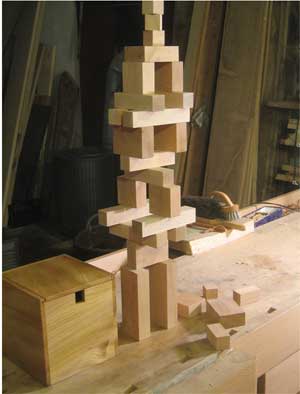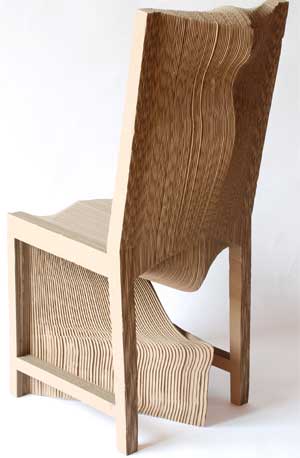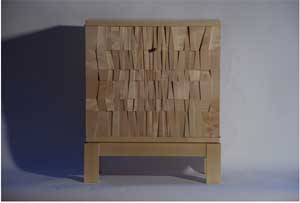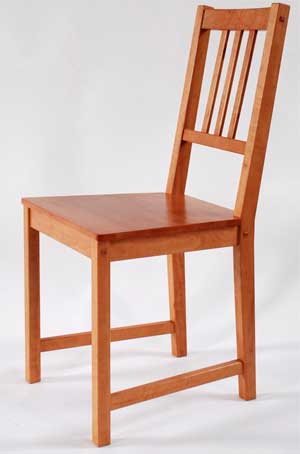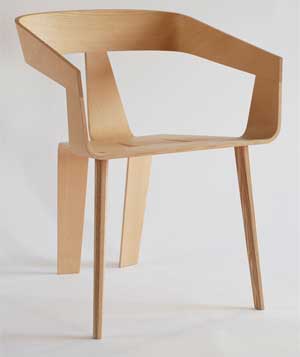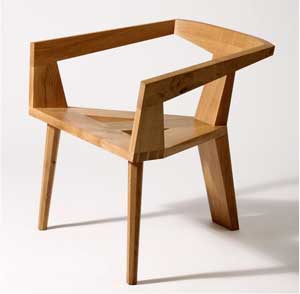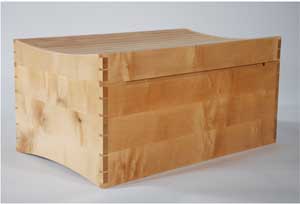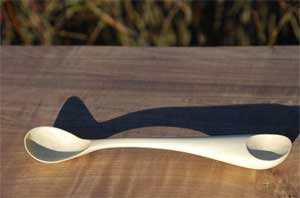
Individually, Rebecca Yaffe and Laura Mays each considered becoming an architect — and ended up becoming a woodworker. Laura, who obtained a degree in architecture after high school, spent a bit of time in that career before coming to the conclusion that “the distance from making things was frustrating, and I didn’t know how to tell other people how to make things if I didn’t know myself.” She ended up taking a course in furniture design and making in her native Ireland — at a school where she later taught.
Rebecca, on the other hand, quickly moved away from her planned architecture major in college, and ended up doing American studies with a focus on the material culture history of New England. “I had a longstanding interest in being a furniture maker, without a real clue what that meant or a starting entry point. I tried to make it academic.”
“I had a fantasy of an apprenticeship with an old man,” Rebecca said, “but the shop situations I found myself in were big kitchen shops that just were not satisfying.”
Both women eventually found themselves as students in the woodworking program at the College of the Redwoods in Fort Bragg, California. The college’s woodworking program, says Laura, who assumed the role of lead instructor there in August 2011, “takes people of all sorts of experience and background.” Rebecca, for instance, chimed in, “There was so much I didn’t know. Like what a band saw was.”
Their class, that of the years 2002 and 2003, spanned the last year of program founder James Krenov’s teaching at the school and the first year of his retirement. Experiences at the school, Laura said, “have influenced us enormously — not necessarily stylistically, but more in terms of thinking about the human element, the material, the way of working, rather than ‘how to fit a door.'”
After completing their studies at the College of the Redwoods, Rebecca returned to Ireland with Laura, which led to the founding of their Yaffe Mays woodworking partnership. “We’re a couple, and it’s kind of an extension of being involved with each other’s work. We shared such a vocabulary being in it together.”
Each partner, Laura said, does tend to work on her own pieces, but “we talk about it an awful lot with each other. And if there’s a deadline looming, the other one will jump in and help.”
The few true collaborations they have done include a series of cabinets, with the same carcass but different visual variations on the fronts, and a box for the Hunt Museum in Limerick, Ireland. The front for one of those cabinets was a door “made of little scraps of wood fitted together,” Rebecca said, which has piqued her interest currently in “shingling and layering, using small pieces of wood to create a more complicated texture.”
Normally, she said, she the techniques she finds herself using over and over again are the traditional joinery techniques such as dovetails and mortise-and-tenon joinery.
For Laura, “I’m increasingly drawn to the vernacular furniture of Ireland, England and the United States: the simple things, like coopering and steam bending. It seems very primal, just using fire and water to bend wood. I’m interested in using those technologies to move into something that’s contemporary — and also fine furniture, rather than a barrel.”
For instance, as part of completing her master’s degree in Ireland, she did parallel series of chairs, one based on the traditional Irish “Sligo” chair, and the other on a basic chair from IKEA. “It’s the modern vernacular, what’s in people’s houses in the same way as the vernacular furniture of 200 or 300 years ago,” she said. Laura broke both chairs down into the basic pattern to explore questions like “what makes it a Sligo chair” and remade them in different ways — such a bent and laminated Sligo with curved parts.
In part, Laura said, her work is an exploration of the objects around us as craft, and making a connection with them in terms of where the object came from and how it was made. “It’s my niggling obsession: how does craft fit into the modern world?”
Her series, she said, “also made me very interested in chairs themselves: their three-dimensional sculptural quality as compared to other furniture, and the way they’re made to carry a message as well as to sit on.”
In the move from Ireland back to California, Rebecca said, “We moved 23 chairs.”
They also moved away from some of the woods they’d been regularly using. Using woods native to the area where she’s located, Rebecca said, “is one of the deeper pleasures of woodworking for me. It’s picturing what you’re making, where it’s going, who’s going to touch it in all the little corners, and being connected to the trees in the ground.”
That said, “I will miss Irish/English sycamore a lot,” she said. “Those are the only pieces I’ve ever made that required not a lick of sandpaper; you can just plane it to a glossy beauty. And I really like working with pear, even though I’ve only worked with imported. It’s so creamy and pink; I find it lovely, and I can’t throw away even the tiniest scrap of it.”
Laura also likes the focus on native trees, and “making a connection with where you are, given that it’s possible. It’s exciting. And you meet interesting people, and that’s part of the connection, as you’re phoning up people who’ve had a tree fall down in their yard to see if you can get it milled up.” Currently, she’s working on a chair in madrone, a species native to California — which has fewer hardwoods, she noted, than the U.S. East Coast. Trees in the Eastern United States, she said, are the same species as those in Ireland, but grow slightly different.
In Ireland, Rebecca said, when it comes to making those personal connections, “Laura went to elementary school with everybody, as far as I can tell. In our time in Ireland, we had a lot of commissions where we knew the family, or we knew the tree.”
“We made two sideboards for old family friends of my parents, from an old cherry tree,” Laura said. “I remembered swinging on that tree as a child.”
Currently, they are renting a shop in California, but, after selling all their machines in Ireland and making the intercontinental move with the 23 chairs, two cats and a dog, “We plan on digging in here and giving it everything,” said Rebecca.
